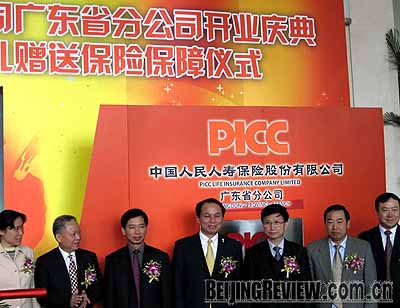| Numbers of the Week
39 %
The insurance industry in China collected a total of 978 billion yuan ($144 billion) in premiums, an increase of 39.1 percent year on year, the highest annual growth since 2002, according to the China Insurance Regulatory Commission.
$78.4 billion
China conducted cross-border mergers and acquisitions valued at $78.4 billion in 2008, according to Thomson Reuters data.

TO THE POINT: The Chinese economy maintained stable and relatively fast growth in 2008 with eased inflation. Its GDP grew 9 percent last year, the first single-digit growth since 2002, and accounted for 20 percent of the global economy. Economists hope that the latest rescue measures adopted by the Central Government could boost the country's economic performance in 2009. Inflation was brought under control as the consumer price index grew a satisfactory 1.2 percent in December year on year. The urban registered unemployment rate was 4.2 percent, indicating an increase in layoffs due to the fallout of the global financial crisis. The money supply also remained stable after the government decided to adopt an accomodative monetary policy in the second half of 2008. Domestic automakers reported sales volume growth of 6.7 percent last year, their lowest in a decade.
By LIU YUNYUN
China's Economic Performance in 2008
GDP
According to a preliminary calculation by the National Bureau of Statistics (NBS), China's gross domestic product (GDP) grew 9 percent year on year in 2008, 1 percentage point higher than the targeted growth set by the Central Government at the beginning of last year.
Ma Jiantang, the NBS Commissioner, said at a press conference on January 22 that China overcame the enormous pressure of the global economic downturn, and the national economy grew relatively fast with stabilized consumer prices, an upgraded industrial structure and improvements to people's livelihoods. Ma said China contributed over 20 percent to global economic growth in 2008.
China's GDP stood at 30.067 trillion yuan ($4.39 trillion) in 2008, mostly driven by the secondary and tertiary industries, which contributed 14.6 trillion yuan ($2.1 trillion) and 12 trillion yuan ($1.7 trillion), respectively.
More noticeably, the GDP growth rate dropped quarterly. It grew 10.6 percent in the first quarter, 10.1 percent in the second quarter, 9 percent in the third quarter, and a mere 6.8 percent in the fourth quarter.
Economists had warned of economic slowdown risks, and many agreed that 2009 might be the toughest year for China as well as the world at large, including plummeting company profits, bankruptcy possibilities and rising unemployment. The fourth-quarter GDP growth slowdown had partly justified economists' concerns.
But Ma said he was confident about China's economy in 2009, because the Central Government had taken a series of measures to boost economic performance, such as easing the money supply and offering incentives to boost consumption.
CPI
The consumer price index (CPI), a barometer of inflation, grew 5.9 percent in 2008, indicating the country was under inflationary pressure, as 3 percent is generally regarded as a safe line.
Although the CPI growth rate remained high for the entire year, it dropped month on month. The December CPI grew a mild 1.2 percent year on year, while the February CPI soared 8.7 percent.
Ma said the falling CPI was a hard-won accomplishment in that it only took half a year to bring the runaway inflation rate from 8 percent down to less than 5 percent, which was almost the shortest time period in the history of NBS calculations.
The NBS report on January 22 showed food prices surged 14.3 percent, making it the biggest propellant of overall consumer price growth.
Ma said the government had intended to control CPI growth rate within 4 percent in 2009.
PPI
The producer price index (PPI), another gauge of inflation at the wholesale level, grew 6.9 percent in 2008, mostly driven by rising raw material, fuel and energy prices.
Just like consumer prices, the country's producer prices dropped in terms of monthly figures. After reaching a peak of 10.1 percent growth in August, the PPI dropped 1.1 percent in December, easing the pain of inflation but arousing fears of deflation.
At the press conference, Ma avoided the question of whether deflation would be a problem, but stressed that China could weather the global financial crisis and maintain stable growth in 2009.
Employment
China recorded urban registered unemployment of 4.2 percent at the end of 2008, a 0.2-percentage-point increase over that of 2007, according to the official figure.
The government had suggested that companies not lay off staff during times of economic fluctuation, and local governments had enacted detailed measures to encourage employment.
| 